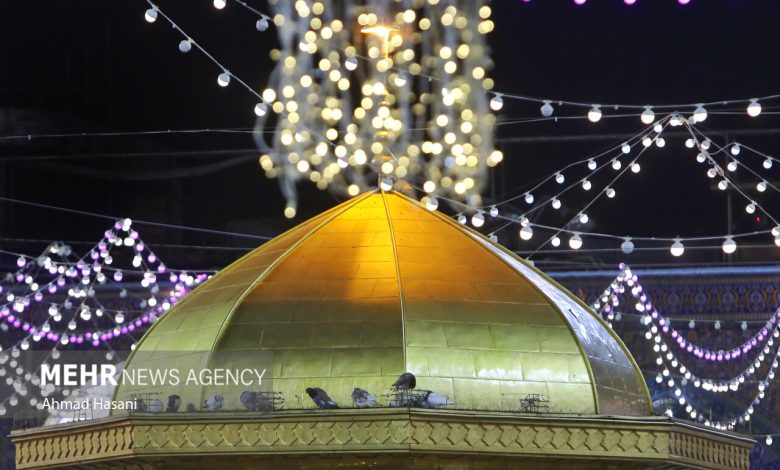Muslims Mark Birth Anniversary of Imam Reza (AS) with Celebrations
Today marks the birth anniversary of Imam Reza (AS), the eighth Imam of Shia Islam. This report offers a concise overview of Imam Reza's life, spanning from his birth to his martyrdom.

Ali ibn Musa al-Rida, frequently referred to as Imam Reza, was a direct descendant of the Prophet Muhammad and the eighth Imam in the lineage of Twelver Shia Islam, following in the footsteps of his father, Imam Musa al-Kazim.
On the anniversary of Imam Reza’s birth, numerous Muslims worldwide embark on a pilgrimage to his sacred shrine located in Iran.
Imam Reza’s life is marked by significant contributions to Islamic scholarship and spiritual leadership. As one of the revered figures in Islamic history, his legacy includes a deep commitment to the principles of his faith and the well-being of his followers. Imam Reza’s teachings emphasized compassion, wisdom, and the pursuit of knowledge, which continue to influence many around the world. His life journey is celebrated for promoting dialogue and understanding within the Muslim community and beyond.
Imam Reza (AS) was born on the 11th of Zul-Qa’dah in the year 148 AH in Medina, which is situated in present-day Saudi Arabia. There is a discrepancy regarding the exact day of his birth, with sources citing either Thursday or Friday.
Ali, son of Imam Musa-ibn-Jafar, was given his name by his cherished father. Recognized with the divine title of al-Reza, signifying profound satisfaction from both Allah and His messenger, he was also known by the agnomen Abul Hasan.
The commencement of his significant period of Imamat occurred in 183 A.H. when he was thirty-five years old, and he maintained this esteemed spiritual leadership for approximately two decades.
During his era, three caliphs from the Abbasid dynasty were contemporaries: Haroon al-Rashid for the initial decade, followed by Amin for a subsequent five years, and lastly Ma’mun for the final five years of his time.
Upon assuming the role of Imamat, Imam Reza (AS) found himself during the era of political governance by Haroon al-Rashid, the Abbasid caliph ruling from Baghdad. Haroon al-Rashid’s administration, primarily characterized by its autocratic approach, gradually began to falter due to widespread rebellions weakening its grasp on power. Amidst this context, Imam Reza (AS) openly declared his Imamat in Medina, dedicating himself to addressing the community’s social issues and resolving matters related to belief and faith.
The era of Imam Reza’s life and leadership marks a time when the public’s inclination towards the Ahl al-Bayt, known for their infallibility and purity, reached its zenith. This period also saw the significant widening of their popular base.
**Imam Reza in Iran**
Iran is home to the revered Imam Reza shrine, a significant religious site that draws millions of pilgrims from around the world. Located in the city of Mashhad, this shrine is dedicated to Imam Reza, the eighth Imam of Shia Islam. The site is not only a pivotal place of worship but also a cultural and historical landmark, contributing to Iran’s rich religious heritage and attracting both devotees and tourists alike.
The Imamate of Hazrat Reza spanned two decades, with the initial seventeen years based in Medina and the concluding three years in Iran’s Khorasan region.
Following the death of Haroon, his son Ma’mun ascended to power, assuming the role of caliph.
During this era, the Shiite community maintained their reverence for Imam Reza, acknowledging him as both their spiritual leader and rightful caliph. The Abbasid caliph, apprehensive of Imam Reza’s widespread recognition as the Prophet’s true successor, devised a plan to bring the Imam to Marv under the guise of friendship. The caliph’s ulterior motive was to project an image of legitimacy for his regime by associating closely with Imam Reza within his court.
Initially, Imam Reza (AS) refused the invitation presented to him. However, as the situation escalated into a threat, he was compelled to travel to Khorasan in 200 A.H. in order to prevent potential conflict among the Shiites. Imam Reza (AS) openly expressed his discontent with this enforced migration.
Imam Reza, expressing his reluctance towards his impending journey, paid repeated visits to the sacred shrine of the Holy Prophet. Through his fervent pilgrimage, it was evident to observers that the journey did not have his approval.
In a poignant moment, the Imam gathered his relatives and friends, urging them to weep for him, as he would not be returning to Medina. This gesture underscored his awareness of Ma’mun’s ominous intentions, yet highlighted his lack of options but to comply with the ruler’s verdict.
Upon Imam Reza’s arrival in Marv, the seat of power for Ma’mun, he received a ceremonial reception from Ma’mun along with several prominent Abbasid dignitaries.
Initially, Ma’mun proposed the caliphate to Imam, who firmly declined the offer. Imam responded by stating that if the caliphate was indeed Ma’mun’s rightful position, as divinely ordained, he had no right to pass on this responsibility. He further elaborated that if Ma’mun’s claim to the caliphate was not legitimate, he could not offer Imam something that did not belong to him.
Subsequently, Ma’mun put forth a proposal for the Imam to accept the position of heir apparent. The Imam initially rejected the offer but ultimately was coerced into accepting the role.
Prior to this, Imam (AS) established specific conditions indicating a refusal to engage in governmental affairs or in the selection or removal of government officials. This demonstrated that Imam (AS) did not assume any formal responsibility within state matters, as he did not acknowledge the legitimacy of Ma’mun’s government.
Imam Reza’s martyrdom is commemorated solemnly, marking a significant event in the religious calendar. This occasion is observed with deep reverence by many, serving as a moment to honor the life and contributions of the revered figure in Islamic history. Numerous ceremonies and gatherings are held to reflect on his legacy and impact within the community.
As Ma’mun’s strategic efforts proved unsuccessful and the popularity and admiration for Imam Reza (AS) continued to rise, he resolved to resort to poisoning the respected Imam.
Historical accounts suggest that Ma’mun administered poison through grapes or pomegranates, leading to the martyrdom of Imam (AS) in 203 A.H.
He was interred in Toos, located in Mashad, Iran, at his prominent shrine.
The son of Imam, known as Imam Jawad (AS), performed the funeral rites for his father, including the ceremonial washing and prayer, though these acts were not publicly recognized. The Imam’s body found its final resting place in Mashhad, accompanied by a significant gathering of his Shias and followers. For centuries, the holy shrine of Imam Reza (PBUH) has remained a source of blessing and pride for the Iranian people.
The revered Imam Reza shrine, located in Mashhad, stands as one of the most significant religious and cultural landmarks in Iran. Known for its stunning architecture and historical importance, this shrine attracts millions of pilgrims and visitors each year.
Imam Reza’s holy shrine stands as the largest and most significant religious center in Iran, exemplifying the quintessential elements of Persian-Islamic architecture. Annually, it attracts a multitude of pilgrims both from within Iran and across the globe.
The holy shrine of Imam Reza is an expansive complex featuring the shrine itself, alongside courtyards, porches, a museum, a library, four seminaries, a cemetery, the Razavi University of Islamic Sciences, a dining facility for pilgrims, extensive prayer halls, and various other structures.
Goharshad Mosque, an impressive congregational edifice erected during the Timurid era, is situated in Mashhad, Razavi Khorasan Province, Iran. Today, it functions as one of the prayer halls within the Imam Reza shrine complex.
The mosque, renowned as the oldest in Mashhad, stands as a captivating cultural, historical, and religious attraction owing to its mesmerizing beauty.
Mirror work, an integral element of Iranian art, serves as a specialized form of architectural decoration. Its roots trace back to the Safavid era, with its prominence heightening during the Qajar period. This art form quickly took hold in Mashhad, largely attributed to the presence of the Shrine of Imam Reza (AS), establishing the city as a central hub for this intricate craft.
The Shrine of Imam Reza (AS) boasts an array of sites and porticos adorned with an exquisite and diverse display of mirrors.







